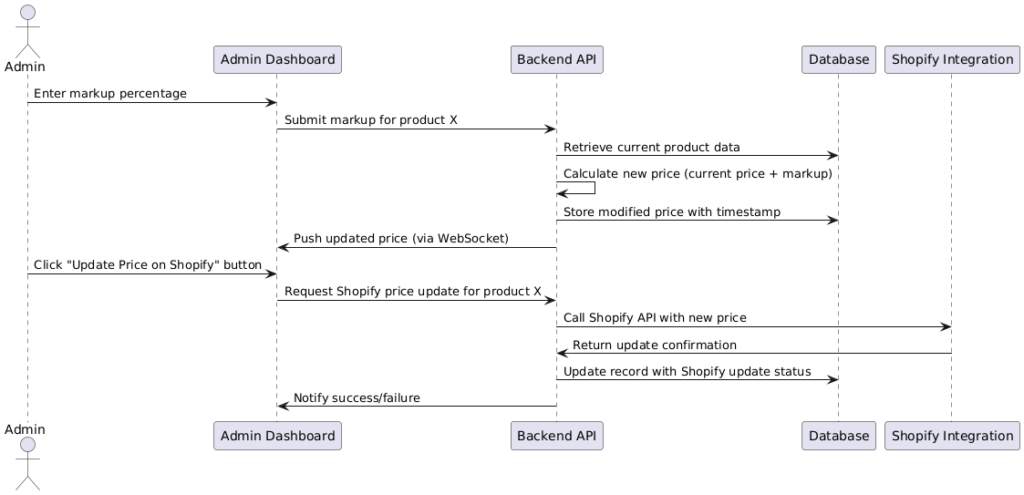
1. High-Level Overview
Our application consists of the following main modules:
-
Data Ingestion Module
- Responsibility: Poll Amazon for product details (price, image, description, stock, delivery date) via the Oxylabs API.
- Process: Extracts and normalizes data, then writes it into the database along with timestamps.
- Scheduling: Can be implemented using a scheduler (cron jobs or a task queue like Celery/RabbitMQ).
-
Database
- Responsibility: Persist raw product data and later store the modified price (with markup) along with timestamps.
- Suggestions: PostgreSQL or MongoDB depending on our query and scalability requirements.
-
Backend API Server
- Responsibility:
- Serves as the middleware between the frontend and the backend services.
- Provides REST (or GraphQL) endpoints for fetching product data.
- Processes markup calculations, saves updates, and triggers Shopify updates.
- Pushes real‑time updates (via WebSockets) to the Admin Dashboard.
- Tech Options: Node.js with Express, Python (FastAPI or Django), or any other modern backend framework.
- Responsibility:
-
Real-Time Communication Server
- Responsibility:
- Delivers live updates to the Admin Dashboard (e.g., using WebSockets with Socket.io).
- Integration: Could be integrated within our Backend API Server or as a dedicated microservice.
- Responsibility:
-
Admin Dashboard (Frontend)
- Responsibility:
- Display real‑time product data.
- Allow the admin to apply a percentage markup.
- Provide a control (button) for each product to trigger the update on Shopify.
- Tech Options: Modern JavaScript frameworks such as React, Angular, or Vue.js.
- Real-Time: Use WebSocket clients (e.g., Socket.io client) to receive live updates.
- Responsibility:
-
Shopify Integration Module
- Responsibility:
- When an admin approves a price update, this module calls the Shopify API to update the product’s price in real time.
- Security: Ensure that the API credentials and tokens for Shopify are securely stored and managed.
- Responsibility:
-
Monitoring & Logging
- Responsibility:
- Monitor data ingestion jobs, API performance, error handling, and system alerts.
- Tools: Prometheus, Grafana, and the ELK stack (Elasticsearch, Logstash, Kibana).
- Responsibility:
2. Data Flow & Component Interaction
-
Data Ingestion:
- A scheduled job (or continuously running service) uses the Oxylabs API to fetch real‑time product data from Amazon.
- The Data Ingestion Module processes and stores the data in the Database with the current timestamp.
-
Real-Time Dashboard:
- The Backend API Server queries the Database and pushes live updates to the Admin Dashboard via WebSockets.
- The dashboard displays the current price along with product details.
-
Price Markup & Update:
- An admin enters a markup percentage on the dashboard.
- The Backend API calculates the new price and stores it (with a timestamp) in the Database.
- The dashboard immediately reflects the modified price.
-
Shopify Update:
- Upon clicking the “Update Shopify” button, the Backend API triggers the Shopify Integration Module.
- The module calls the Shopify API to update the product’s price in our Shopify store.
- A confirmation is received and the database is updated accordingly.
-
Feedback Loop:
- Any successful updates (or errors) are fed back into the system and displayed on the dashboard for transparency.
3. Suggested Tools & Tech Stack
| Layer | Technology Options |
|---|---|
| Frontend | ReactJS / Angular / Vue.js, with real-time libraries such as Socket.io-client |
| Backend | Node.js with Express, Python (FastAPI/Django), or Java (Spring Boot) |
| Database | PostgreSQL (for relational integrity) or MongoDB (for flexibility and scalability) |
| Task Scheduling | Cron jobs, Celery (Python), Bull (Node.js), or RabbitMQ for asynchronous processing |
| Real-Time Updates | Socket.io (for WebSocket communication) |
| Shopify API | Official Shopify API libraries (available for Node.js, Python, etc.) |
| Containerization | Docker, with orchestration via Kubernetes if scaling is required |
| Monitoring | Prometheus, Grafana, ELK (Elasticsearch, Logstash, Kibana) |
| Authentication | JWT/OAuth for secure API access between modules and for admin authentication |
4. Additional Considerations & Requirements
-
Authentication & Security:
- Use API keys and tokens for secure communication with Oxylabs and Shopify.
- Implement admin authentication (e.g., using JWT or OAuth) on the dashboard and API endpoints.
-
Error Handling & Retry Logic:
- Implement robust error handling and retry mechanisms in the Data Ingestion and Shopify Integration modules.
- Log errors for later analysis and use monitoring tools to alert on failures.
-
Scalability & Performance:
- Consider caching frequently accessed data.
- Use load balancing for your backend services if the number of products or request rate is high.
- For very high-frequency updates, a message queue (e.g., RabbitMQ or Kafka) can help decouple and process tasks asynchronously.
-
Deployment & CI/CD:
- Containerize your services using Docker.
- Use CI/CD pipelines (e.g., GitHub Actions, Jenkins) for automated testing and deployment.
-
Data Retention & Analytics:
- Optionally, store historical data to analyze price trends over time.
- Provide admin reports and dashboards for analytics.
. Outro
This design outlines a modular and scalable approach:
- Data Ingestion gathers real‑time product data.
- Backend API processes data, calculates markups, and communicates with both the Admin Dashboard and Shopify.
- Real-Time Communication ensures the dashboard stays updated as Amazon prices fluctuate.
- Shopify Integration lets admins push approved price changes to their online store.
